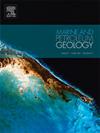Differential diagenetic controls on petrophysical heterogeneity of lacustrine beach-bar tight sandstones: Insights from the Boxing Sag, eastern China
IF 3.6
2区 地球科学
Q1 GEOSCIENCES, MULTIDISCIPLINARY
引用次数: 0
Abstract
The Bohai Bay Basin is rich in petroleum resources, and the lacustrine beach-bar tight sandstone facies in the upper part of the fourth Member of the Paleogene Shahejie Formation (Es4s) of the Boxing Sag is a key exploration target. However, the heterogeneity in petrophysical properties caused by differential diagenesis during burial impacts its development. In this study, an integrated approach is used that includes core and thin section descriptions, scanning electron microscopy (SEM), carbon and oxygen isotope analysis, fluid inclusion analysis, rock physical properties, and high-pressure mercury injection analyses to investigate the differential diagenesis of the beach-bar tight sandstone reservoirs and its effects on petrophysical heterogeneity. Key findings include: (1) The sequence of diagenetic evolution of the reservoirs is: mechanical compaction and spherical pyrite cementation → calcite and dolomite cementation → feldspar dissolution, authigenic kaolinite precipitation, and quartz overgrowth → ferro-calcite and ankerite cementation → secondary dissolution and quartz overgrowth → late agglomerate pyrite cementation, reflecting alternating alkaline and acidic diagenetic environments. (2) Mechanical compaction and cementation are the dominant factors responsible for the reduction in reservoir quality. (3) Four distinct diagenetic facies are identified: an intense compaction with intergranular dissolution diagenetic facies (DF-I), an intense compaction with residual intergranular porosity diagenetic facies (DF-II), a weak-moderate compaction with intergranular cementation diagenetic facies (DF-Ⅲ), an intense compaction with matrix occlusion diagenetic facies (DF-Ⅳ). DF-I and DF-II exhibit superior reservoir quality (porosity >10 %, permeability >0.1 mD), making them effective reservoirs. (4) The genesis and spatial distributions of these facies are controlled by the petrological structure, petrographic composition, sand-mud interface, mudstone thickness, and distance from oil-source faults. By integrating multiple factors, this study elucidates the genetic mechanisms of the four diagenetic facies and establishes their vertical distribution patterns. This provides a basis for predicting favorable reservoir distribution and guiding future exploration.
湖相滩坝致密砂岩岩石物性非均质性的差异成岩控制:来自中国东部博兴凹陷的启示
渤海湾盆地油气资源丰富,博兴凹陷古近系沙河街组四段上段湖相滩坝致密砂岩相是重点勘探对象。但埋藏过程中差异成岩作用导致的岩石物性非均质性影响了其发育。本研究采用岩心和薄片描述、扫描电镜(SEM)、碳氧同位素分析、流体包裹体分析、岩石物性和高压压汞分析等综合方法,研究滩坝致密砂岩储层的差异成岩作用及其对岩石物性非均质性的影响。主要发现:(1)储层成岩演化顺序为:机械压实和球形黄铁矿胶结作用→方解石和白云石胶结作用→长石溶蚀、自生高岭石沉淀、石英过生长→铁方解石和铁白云石胶结作用→次生溶蚀和石英过生长→晚期块状黄铁矿胶结作用,反映了碱性和酸性交替的成岩环境。(2)机械压实作用和胶结作用是导致储层质量降低的主要因素。(3)识别出4种不同的成岩相:强压实-粒间溶蚀成岩相(DF- i)、强压实-残余粒间孔隙成岩相(DF- ii)、弱-中度压实-粒间胶结成岩相(DF-Ⅲ)、强压实-基质封堵成岩相(DF-Ⅳ)。df - 1和df - 2具有较好的储层质量(孔隙度10%,渗透率0.1 mD),为有效储层。(4)这些相的成因和空间分布受岩石学构造、岩相组成、砂泥界面、泥岩厚度和离油源断裂的距离等因素的控制。综合多种因素,阐明了四种成岩相的成因机制,建立了四种成岩相的垂向分布模式。这为预测有利储层分布和指导今后勘探提供了依据。
本文章由计算机程序翻译,如有差异,请以英文原文为准。
求助全文
约1分钟内获得全文
求助全文
来源期刊

Marine and Petroleum Geology
地学-地球科学综合
CiteScore
8.80
自引率
14.30%
发文量
475
审稿时长
63 days
期刊介绍:
Marine and Petroleum Geology is the pre-eminent international forum for the exchange of multidisciplinary concepts, interpretations and techniques for all concerned with marine and petroleum geology in industry, government and academia. Rapid bimonthly publication allows early communications of papers or short communications to the geoscience community.
Marine and Petroleum Geology is essential reading for geologists, geophysicists and explorationists in industry, government and academia working in the following areas: marine geology; basin analysis and evaluation; organic geochemistry; reserve/resource estimation; seismic stratigraphy; thermal models of basic evolution; sedimentary geology; continental margins; geophysical interpretation; structural geology/tectonics; formation evaluation techniques; well logging.
 求助内容:
求助内容: 应助结果提醒方式:
应助结果提醒方式:


